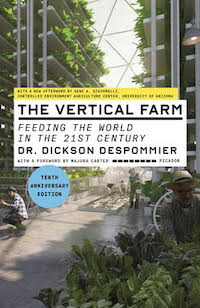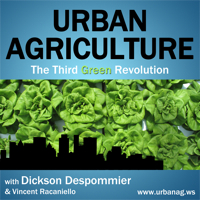I was about to give my rehearsal talk at a recent TEDx conference when a rather distinguished looking older woman (another presenter at the same conference) approached me, and with a stern facial expression that one could only interpret as constrained hostility, stared directly into my eyes and confronted me: ”Please stop this foolish crusade advocating for vertical farms in cities. A man with your amount of influence and education should know better”. She stopped just short of poking her index finger deeply into my chest as she ranted. Having finished her tersely delivered directive, she pivoted smartly in military fashion and walked off into the empty darkened auditorium to await her turn at our practice session. I barely had the opportunity to thank her for being so forthright, candid, and above all fearless about expressing her opinion of urban agriculture, and in specific for my role in propagating enthusiasm for it. Remarkably, I resisted following her to her seat and getting into a heated argument/discussion with her about climate change and the demise of agriculture in general. Instead, I went on about the business at hand and gave my eighteen minutes on the virtues of urban agriculture and the role that vertical farming might play in its development. It occurred to me upon much reflection that what she really might have meant to say was that vertical farming will never be able to replace outdoor farming so why bother trying. In her own talk, she spoke passionately of the population explosion and too many mouths to feed, but did not expound even a little as to what she might want do to alleviate the situation. Her primary concern appeared to be about her newly arrived grandchild and the depressing future it and the next few generations of humans will have to face. Very depressing, really. Her message was not dissimilar from that of Al Gore or James Lovelock as to the state of the planet; lots of depressing data and no apparent solutions on the horizon. In all my experience as a public speaker I do not recall ever having expressed the idea that vertical farming should replace all outdoor farming as the only solution to the ills of the world. Nonetheless, I think that was her take on what I was all about. Suffice it to say that since then I have endeavored to give better reasons for insinuating agriculture into the build environment.
Lets begin the argument in favor of urban agriculture by admitting that cities are the main reason we are in such a bad state of affairs with respect to rapid climate change and its deleterious effects on traditional agriculture. In 2011 for example, the United States lost some 110 billion dollars worth of grain crops due to a protracted drought throughout the American Midwest. Unless a miracle happens, it appears almost certain that the state of California will be the next victim of drought in 2014. This could affect virtually every US citizen, with significantly higher food prices and may even affect food availability, as well. Cities only occupy some 2-3 percent of the Earth’s landmass, but emit over seventy percent of the atmospheric carbon dioxide. Nearly fifty percent of us now live in cities. Seven billion people require farmland equivalent in landmass to the size of South America. This calculates out to an astounding 6,890,000 square miles! That means that cities need some 3,440,000 square miles of land to satisfy their daily caloric needs. From 1950s to the present, the Brazilian rainforest has been negatively impacted by encroachment, mainly for the sake of agriculture, sacrificing some 700,000 square miles of hardwood forest for farmland to feed its own growing population. Hm, you might say. Up to this point, the facts I’ve just presented seem to support the outlook forecasted by the doomer gloomers. But the built environment need not shoulder the entire burden of food production for there to be real hope for straightening out the mess we have made for ourselves. If cities produced just ten percent of the ground crops they currently consume, by employing sustainable indoor vertical farms and greenhouses to do so, then nearly half of the damaged portion of the Brazilian rainforest could theoretically be restored (340,000 square miles worth) and a significant amount of carbon would be sequestered as the result. This calculation is based on the fact that indoor farming is carried out year round and is over ninety percent efficient at producing food crops. By the way, outdoor farming is, at best, only fifty percent successful (insect pests, plant diseases, adverse weather conditions) and can only occur at temperatures that consistently average 55 degrees Fahrenheit. Enabling cities to be productive centers for locally grown vegetables, herbs, and fruits, might be all that is needed to turn the corner to a more sustainable future.
Ultimately, I strongly believe that we should work towards the creation of eco-cities that mimic in every way the functions necessary for sustaining an intact ecosystem, using our creative intellects and cutting-edged technologies to get the job done. Primary productivity is an essential feature of all ecosystems, so why not start with this activity as the basis for creating the eco-city? Today, it is easy to do, witness all the new varieties of vertical farms and rooftop greenhouses going up inside the built environment. Generating just ten percent of our farm production within the world’s cities just might be enough needed to slow down our runaway climate regime and give us some much needed time to figure out ways of dealing with rising sea levels, as the climate continues to challenge our quality of life on Planet Earth.


{ 0 comments… add one now }